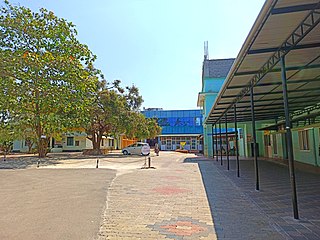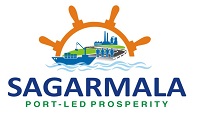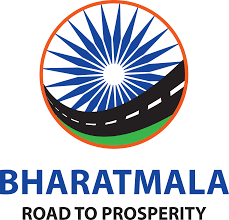
The North–South–East–West Corridor (NS-EW) is the largest ongoing highway project in India. It is the second phase of the National Highways Development Project (NHDP), and consists of building 7300 kilometers of four/six lane highways associating Srinagar, Kanyakumari, Kochi, Porbandar and Silchar, at a cost of US$12.317 billion ₹1000000000000(One lakh Crore INR). As of 19 March 2024, 6875 of the 7142 kilometers project has been finished.

The National Highways Development Project (NHDP) was a project of four laning of existing national highways and six laning of selected major national highways of India. The project was started in 1998 under the leadership of Prime Minister, Atal Bihari Vajpayee. National Highways account for only about 2% of the total length of roads, but carry about 40% of the total traffic across the length and breadth of the country. This project is managed by the National Highways Authority of India (NHAI) under the Ministry of Road, Transport and Highways. The NHDP represents 49,260 km of roads and highways work and construction in order to boost economic development of the country. The government has planned to end the NHDP program in early 2018 and subsume the ongoing projects under a larger Bharatmala project.

Bengaluru Suburban Railway is an under-construction suburban rail network for the city of Bangalore. A suburban rail system for the city was first proposed in 1983. Since then, several different route proposals were made but no suburban rail project took shape. It was finally approved in the 2019 Railway Budget.

Expressways are the highest class of roads in India. As of December 2024, the total length of expressways in India was 6,059 km (3,765 mi), with 11,127.69 km (6,914.43 mi) under construction. As per NHAI and Indian Roads Congress, expressways are access controlled highways with a divided carriageway, designed for high speed vehicular movement and heavy traffic. There is a central reservation or median that separates the flow travelling in opposite directions. Entrance and exits are provided only by grade separated interchanges. The interchanges may be system interchanges used with other national or state highways or be service interchanges used with smaller roads. In contrast, National highways may or may not be divided by a median and may or may not have access control. Some highways, built by State Governments, which may be fully access controlled or may be limited access controlled, are declared or named as expressways by their respective State Governments.
The Indian city of Thiruvananthapuram has a well-developed transport infrastructure. The city and its suburbs may be traversed using road and rail. Within the city, city buses, taxis and auto rickshaws provide mobility. Scooters and motorcycles are the favored means of personal transport. Ola, Uber and other taxi services operate there.

Kingfisher Xpress was a Door-to-Door cargo delivery service from an Indian defunct airline, Kingfisher Airlines. Kingfisher Xpress Same Day service was India's first and only same day delivery by air service.

The Bengaluru–Chennai Expressway, or National Expressway 7 (NE-7), is a partially operational 258 km (160 mi) long, four-lane -wide access-controlled expressway between two of the major metro cities of India, Bengaluru, the capital of Karnataka and Chennai, the capital of Tamil Nadu. It will run from Hoskote in Bangalore Metropolitan Region Development Authority to Sriperumbudur in Chennai Metropolitan Area. It will pass through three states-Karnataka, Andhra Pradesh and Tamil Nadu It allows vehicles to reach a maximum speed limit of 120 km/h (75 mph). The road was designated as a National Expressway on 1 January 2021. The total project value is around ₹17,930 crore (US$2.1 billion).

National Highway 544, commonly referred to as NH 544, is a 340-kilometre-long (210 mi) National Highway in South India connecting Salem city in Tamil Nadu to the city of Kochi in Kerala. It is also called the Salem-Kochi Highway. The highway runs through the states of Kerala and Tamil Nadu, connecting various important cities and towns such as Salem, Erode, Coimbatore, Palakkad, Thrissur and Kochi. It is a spur of National Highway 44, which forms the North South Corridor of the National Highway network of India.It passes south of Coimbatore. NH544 is the only highway in kerala which is completely consists of four lanes. It was formerly designated National Highway 47.

Kanjikode or Kanchikode is an industrial town located 13 km (8.1 mi) east of Palakkad. Kanjikode is the second largest industrial hub in Kerala after Kochi. The town is part of Pudussery Panchayat. It is one of the growing suburbs of Palakkad city. First and the only Indian Institute of Technology in Kerala, Indian Institute of Technology,Palakkad was established in Kanjikode. The upcoming Industrial Smart City project is going to be established in Kanjikode.
The Bengaluru–Mumbai Industrial Corridor (BMIC) is a proposed economic corridor in India between Mumbai and Bangalore. The corridor is spread across the states of Karnataka and Maharashtra and passes through major cities such as Davanagere, Chitradurga, Hubli–Dharwad, Belagavi, Solapur, Kolhapur, Satara and Pune. The overall length of the corridor is around 1,000 km and covers an area of around 143,000 km2. The corridor is delineated around the existing National Highway 48 (NH48), the existing Bangalore-Mumbai railway line and the Dabhol–Bangalore Natural Gas Pipeline.

Nedungolam or Nedumgolam is the Northern border town of Paravur municipality in the Kollam district of Kerala state, India. Nedungolam is very near to the world-famous-wetland in Kollam district, Polachira, which is a favorite destination for migratory birds. A census conducted on 2003 reveals that over 26,000 birds belonging to 37 species are visiting or living in the Polachira wetlands.
An industrial corridor is a package of infrastructure spending allocated to a specific geographical area, with the intent to stimulate industrial development.

The Sagarmala Programme is an initiative by the Government of India to enhance the performance of the country's logistics sector. The programme envisages unlocking the potential of waterways and the coastline to minimize infrastructural investments required to meet these targets.

The Bharatmala Pariyojna was a project in India implemented by Government of India. It was slated to interconnect 550 District Headquarters through a minimum 4-lane highway by raising the number of corridors to 50 and move 80% of freight traffic to National Highways by interconnecting 24 logistics parks, 66 inter-corridors (IC) of total 8,000 km (5,000 mi), 116 feeder routes (FR) of total 7,500 km (4,700 mi) and 7 northeast Multi-Modal waterway ports. The project also includes the development of tunnels, bridges, elevated corridors, flyovers, overpasses, interchanges, bypasses, ring roads, etc. to provide the shortest, jam-free & optimized connectivity to multiple places, it is a centrally-sponsored and funded Road and Highways project of the Government of India.
Kozhikode district has an extensive network of road, rail and air travel services. Kozhikode city is the epicenter of the district. Vatakara and Thamarassery are other transport hubs.

Kannur has a good road network connecting to Bangalore, Mangalore, Kodagu and Cochin. The railway station is also well connected to all parts of India. There is new International airport from Kannur opened on 9 December 2018, other nearest airports are at Calicut and Mangalore. Thalassery, Payyanur, Taliparamba and Iritty are the other transport hubs.

The East Coast Economic Corridor (ECEC) is India’s first coastal economic corridor, covering 2500 km of India's coastline, to be developed with the help of the Asian Development Bank (ADB). The ADB is to invest $500 million in infrastructural development of the project. Since late 2013, ADB has been supporting studies on transport corridors in India. Phase 1 of the ECEC is Visakhapatnam-Chennai Industrial Corridor (VCIC) which had been approved by the ADB board in October 2016. The ECEC running along the entire east coast of India from Kolkata to Kanyakumari, is a multimodal, regional maritime corridor that can play a vital role in unifying the large domestic market, as well as integrating the Indian economy with the dynamic global value chains of Southeast and East Asia. It would play a crucial role in the Government of India’s (GoI) Make in India campaign and also supports the port-led industrialization strategy under the Sagar Mala initiative and the Act East Policy by linking domestic companies with the vibrant global production networks of East and Southeast Asia.
Multi-Modal Logistics Parks (MMLPs) is a key policy initiative of the Government of India, led by National Highways Logistics Management Limited under Ministry of Road Transport and Highways (MoRTH) and the National Highways Authority of India (NHAI), to develop Multi-Modal Logistics Parks in hub-and-spoke model to improve the country's freight logistics sector by lowering overall freight costs and time, cutting warehousing costs, reducing vehicular pollution and congestion, improving the tracking and traceability of consignments through infrastructural, procedural, and information technology interventions.
The Palakkad Industrial Smart City is an under construction greenfield industrial smart city spread over an area of 1,710 acres (6.9 km2) Palakkad district, Kerala, India. It is a part of the Kochi Bengaluru Industrial Corridor Project, The Economic Affairs Committee of the Union Cabinet has approved 12 Industrial Smart Cities in ten states including Palakkad Industrial Smart City in Kerala.













